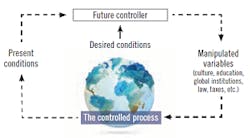A recent column dealt with the control of global warming and Pat Dixon, P.E, PMP, southwest region engineering manager ([email protected]) brought up this logical question: „Why not just control the temperature by throttling the rate of CO2 emission?”
To control a process, we must first fully understand it. The more complex the process, the more difficult that is. So let us look at the heat transfer control loop of global warming (GW).
This heat-transfer process is similar to controlling the temperature of a continuous reactor. The temperature of both stays constant if they receive the same amount of heat as the amount that is removed. When the reactor temperature is rising, we can either reduce the reaction rate (heat input), increase the cooling, or both. In case of the planet, we can reduce the heat input (by reducing CO2 emission), increase cooling by reflecting more solar energy back into space, or both. The second we can do by increasing the albedo by making our roofs, roads and agriculture more reflective.
Now, let us look at the differences between controlling a reactor and the planet. In the reactor, the proportional mode of the PID controller generates a correction in proportion to the size of the error; the integral mode adds its correction based on the accumulated past errors; and the derivative (rate action) contributes its correction based on the rate at which the error is changing.
So, why is this difficult to implement in case of the GW loop? The temperature of our planet was uncontrolled for the past two centuries while our carbon footprint increased, which increased the heat input into the planet. Being uncontrolled, there was no integral correction, so the past errors just accumulated—the carbon in the air increased from about 400 to 880 gigatons (GTC). And, because there was also no derivative action, the process wasn’t protected from continued future temperature rise. If we did this to a reactor, it would have blown up long ago. The planet didn’t because of it's immense capacity. It just kept warming (Figure 1).
Figure 1: During the past 1,500 years, the global temperature rise never exceeded 0.2 °C. Today, it's nearly 1.0 °C and rising. Source: https://earthobservatory.nasa.gov/features/GlobalWarming/page3.php
During the past 1,500 years, the global temperature rise never exceeded 0.2°C and today, it is approaching five times that at nearly 1.0 °C. (The temperature of the oceans increased only 0.5 °C, the land about 2.0 °C and the polar regions around 4.0 °C). Today, there is talk of limiting the rise to 1.5 or 2.0 °C, and to eliminate some or all carbon emission by 2030 or 2040 or 2050, but process control analysis shows that this is wishful thinking.
Now, let us see what would happen if (as Mr. Dixon suggested) we placed a PID controller, with a setpoint of zero temperature rise, on this process? Naturally, the controller would respond to the tremendous error by immediately fully closing the CO2 emission control valve and fully opening the albedo valve. But we can’t just increase reflection or stop using fossil fuels immediately, and even if we could, the planet would still continue to warm because stopping the present emission (10 GTC per year) still leaves the accumulated 880 GTC in the air. So what kind of global warming control loop (GWC) would an experienced process control engineer recommend for this process?
I have spent the past three years studying the dynamics of the various subprocesses of the overall global warming process, and summed up my findings in a book to be published next year by ISA. There is no space here to discuss the dynamic characteristics that I found (linearities, time constants, gains, tipping points,etc.), but I can give a brief summary of the steps needed to configure a GWC.
The big difference between controlling a reactor temperature and the temperature of the globe is that, in case of the reactor, the setpoint (temperature) and the manipulated variable (coolant flow) are different variables, while in case of the GWC, they are the same. This is because humans must control their own behavior, and humans must determine the setpoint of the GWC and respond to its output. This is much harder than throttling the cooling water valve on a reactor.
In case of the GWC, the setpoint (the limit the temperature rise should stay below) is debated and the views of our leaders range from that of the president of the UN (or of the 16 year old girl from Sweden, Greta Thunberg) to those who consider global warming a Chinese hoax. So, as of today, the GWC has no setpoint because of the disagreement between the conclusions of the scientific community and interests of the fossil lobbies.
Figure 2: To activate this control loop, our leaders must agree on the setpoint (desired conditions to be reached) and on the tools to be used to implement it (the manipulated variables), which include changes in the taxes, laws, enforcement institutions, etc.
To build the GWC shown in Figure 2, first the setpoint must be determined by our leaders. Let’s assume that an agreement is eventually reached to reduce the present global emission rate to zero in 10 years. That means that the setpoint of our GWC has to be lowered by 1.0 GTC each year. Once the setpoint is established, the control loop must be completed by a sizing the control valve that is big enough to maintain that setpoint.
As human behavior is the "control valve," to make it effective, the loop must consider human nature and that means it must consider individual self-interest, which usually means money. In other words, emitting carbon must be made more expensive than converting to green energy. This can be achieved by establishing a carbon tax of say, $20 per ton of carbon dioxide equivalent emission (CDE), which is what Canada has today. Once we have the setpoint (1.0 GTC per year) and sized our control valve for $20 per ton, we can start up the loop. If it works with the "small valve" of $20 per ton, fine, if it does not, we increase the "size" of the valve until it does.
The albedo valve
Also, we should keep in mind that we have two control valves. The second valve at our disposal is the albedo effect (increasing the proportion of solar energy we reflect back into space). This is also a powerful tool, to date unused. Therefore, just as carbon taxes should motivate emission reduction, albedo subsidies should also be used to make it profitable for people to convert their roofs, roads, agriculture, etc. to be more reflective.
I checked the albedo potential of our own roof and found that a 50% albedo increase would have the same cooling effect as reducing CO2 emission by 69.5 tons per year. So, if the CDE subsidy was $20 per ton, we would receive a $1,390 yearly subsidy, not to mention that our home would be cooler in the summer.
If my calculation is correct and because the total CO2 emission of mankind is about 36 billion tons per year, if the same thing were done on about 0.5 billion roofs like like ours, this could cool as much as stopping all carbon emission. By the way, at $20 per ton, this would cost "only" about $0.75 trillion, and if there were not enough roof area, we could do the same with roads, agriculture, etc. As to the time constants of the albedo process, it is shorter and is an immediate "job creator."
Interaction of the GWC loop with AI
We are very lucky that the technological challenge of storing, transporting and distributing green energy has already been solved (www.amazon.com/Post-Oil-Energy-Technology-Solar-Hydrogen-Demonstration-ebook/dp/B07LCW9HVS/ref=sr_1_25). We are also lucky that the conversion to the coming solar-hydrogen economy will occur at the very same time when artificial intelligence (AI, through robotics) will be freeing up a large segment of the workforce, which will be needed to implement this transition. In other words, we can have a positive interaction between the GWC and the AI loops.
Obviously, implementing the GWC (converting our energy economy) would be a gigantic task, but so was the Marshall Plan or going to the moon. It would also take a lot of education and overcoming of fossil interests, but remember that, in his time Pope Urban VIII was also pretty powerful and yet Galileo won. So, I am optimistic that this transition can be done in time and that the experience and knowledge accumulated by our automation and control profession will play an important role in implementing it.
Our stone age ancestors switched from using stone to bronze, not because they ran out of stone, but because bronze made better tools. Similarly, we will not wait until we run out of fossil or nuclear fuels, but will recognize that solar and wind are better and will switch now. We know how to switch, we know what to switch to, all that is needed is to shake off our complacency, stop living in delusion and face the threat that is the size of life itself.







